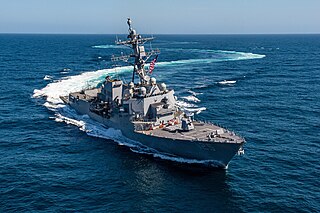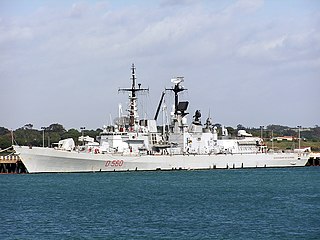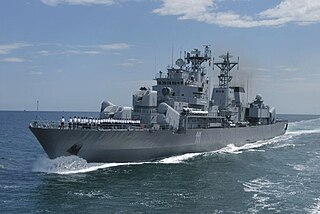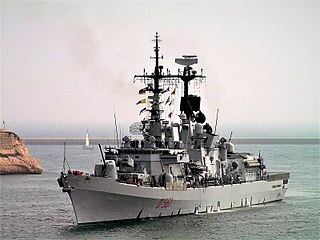
In naval terminology, a destroyer is a fast, maneuverable, long-endurance warship intended to escort larger vessels in a fleet, convoy, or carrier battle group and defend them against a wide range of general threats. They were originally conceived in 1885 by Fernando Villaamil for the Spanish Navy as a defense against torpedo boats, and by the time of the Russo-Japanese War in 1904, these "torpedo boat destroyers" (TBDs) were "large, swift, and powerfully armed torpedo boats designed to destroy other torpedo boats". Although the term "destroyer" had been used interchangeably with "TBD" and "torpedo boat destroyer" by navies since 1892, the term "torpedo boat destroyer" had been generally shortened to simply "destroyer" by nearly all navies by the First World War.

The Arleigh Burke class of guided-missile destroyers (DDGs) is a United States Navy class of destroyer centered around the Aegis Combat System and the SPY-1D multi-function passive electronically scanned array radar. The class is named for Admiral Arleigh Burke, an American destroyer officer in World War II and later Chief of Naval Operations. With an overall length of 505 to 509.5 feet, displacement ranging from 8,300 to 9,700 tons, and weaponry including over 90 missiles, the Arleigh Burke-class destroyers are larger and more heavily armed than many previous classes of guided-missile cruisers.

USS Long Beach (CLGN-160/CGN-160/CGN-9) was a nuclear-powered guided missile cruiser in the United States Navy and the world's first nuclear-powered surface combatant. She was the third Navy ship named after the city of Long Beach, California.

A guided-missile destroyer (DDG) is a destroyer whose primary armament is guided missiles so they can provide anti-aircraft warfare screening for the fleet. The NATO standard designation for these vessels is DDG, while destroyers which have a primary gun armament or a small number of anti-aircraft missiles sufficient only for point-defense are designated DD. Nations vary in their use of destroyer D designation in their hull pennant numbering, either prefixing or dropping it altogether.

The Type 42 or Sheffield class, was a class of fourteen guided-missile destroyers that served in the Royal Navy. A further two ships of this class were built for and served with the Argentine Navy.

The La Fayette class is a class of general purpose frigates built by DCNS in the 1980s and 1990s, operated by the French Navy and three other navies. Derivatives of the type are in service in the navies of Saudi Arabia, Singapore, and Taiwan.

The General Electric LM2500 is an industrial and marine gas turbine produced by GE Aviation. The LM2500 is a derivative of the General Electric CF6 aircraft engine.

The Italian Navy is one of the four branches of Italian Armed Forces and was formed in 1946 from what remained of the Regia Marina after World War II. As of August 2014, the Italian Navy had a strength of 30,923 active personnel, with approximately 184 vessels in service, including minor auxiliary vessels. It is considered a multiregional and a blue-water navy.

A stealth ship is a ship that employs stealth technology construction techniques in an effort to make it harder to detect by one or more of radar, visual, sonar, and infrared methods.

Marquis Luigi Durand de la Penne was an Italian Navy admiral who served as naval diver in the Decima MAS during World War II. He was born in Genoa, where he also died.

The Audace-class destroyers were two guided missile destroyers built for the Italian Navy during the Cold War. An improvement of the Impavido class, these ships were designed for area air defence and also had a heavy gun armament. They were fitted with contemporary American radars and sonars, but also, as the next Italian ships, all the modern weapons made by Italian industry of the time, such torpedoes, helicopters and guns. Also some indigenous radars were fitted.

The Durand de la Penne class are two guided-missile destroyers operated by the Italian Navy. The design is an enlarged version of the Audace class, updated with diesel and gas turbine CODOG machinery and modern sensors. Four ships were planned but the second pair were cancelled when Italy joined the Horizon project.

Mărășești (F111) is a frigate currently serving with the Romanian Navy. Mărășești served as the flagship of the navy between 1985–2004, when Regele Ferdinand became the new flagship. She is the largest warship of the Romanian Navy ever built in Romania.

Spartaco Schergat was an Italian military frogman during World War II.

Caio Duilio is a destroyer of the Italian Navy. She and her sister Italian destroyer Andrea Doria form the Andrea Doria class; in turn these two ships, and the French vessels Forbin and Chevalier Paul, belong to the Horizon class. Caio Duilio is marked by hull number D 554 according to NATO classification.

Andrea Doria is a destroyer of the Italian Navy. She and her sister Caio Duilio form the Andrea Doria class; in turn these two ships, and the French vessels Forbin and Chevalier Paul, belong to the Horizon class. Andrea Doria has the hull number D 553 according to NATO classification.
Animoso was the name of at least three ships of the Italian Navy and may refer to:

Francesco Mimbelli(D 561) is the second ship of the Durand de la Penne-class destroyer of the Italian Navy.

Audace(D 551) is the lead ship of the Audace-class destroyer of the Italian Navy.

Ardito(D 550) is the second ship of the Audace-class destroyer of the Italian Navy.



















